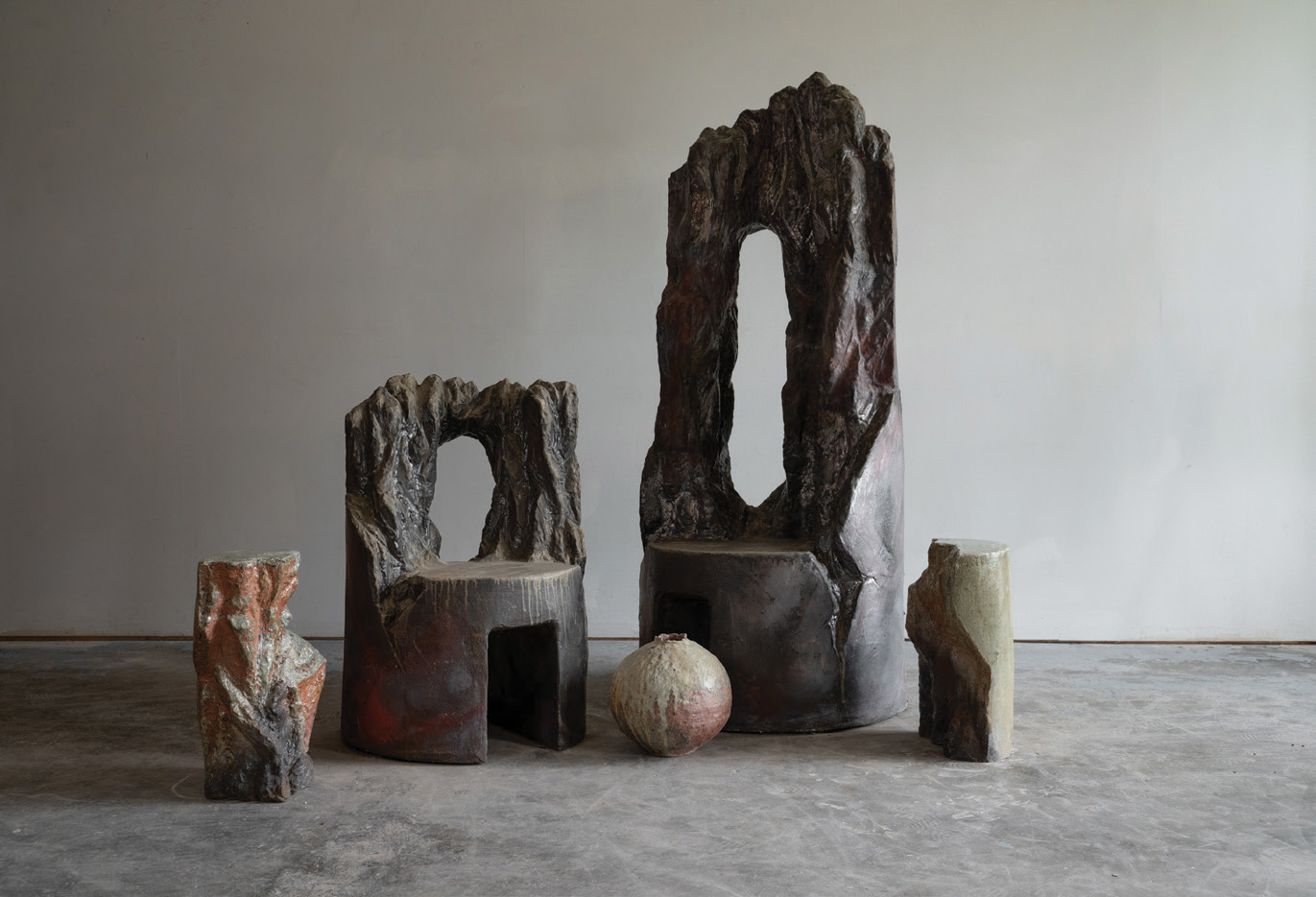
04 Jul Ceramics Born From the Land
The clay Casey Zablocki works with carries half a billion years of geological memory. He reimagines its compressed layers, once part of Montana’s landscape, into sculptures that flirt with a Brutalist style, appearing simultaneously ancient and futuristic.
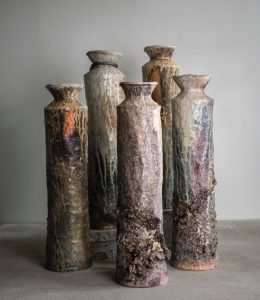
Zablocki’s process brings the unexpected in a range of colors and textures.
Zablocki’s monumental ceramic forms exist between sculpture and furniture — tables, wall-mounted slabs and vases, and his “conversational chairs,” or thrones, which he envisions placed in the woods as places to converse. His pieces are shown and sold internationally and represented by the Roman and Williams Guild in New York City and Stremmel Gallery in Reno, Nevada. And yet, inside his unassuming Missoula, Montana, studio — nestled in an industrial corner on the edge of the city’s historic Westside — the energy is raw, hands-on, and deeply connected to place.
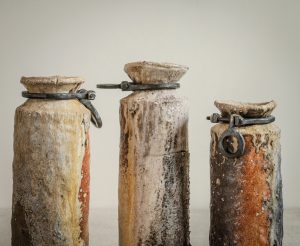
He fitted this group of ceramic wall vases with hand-forged steel collars forged by Nathan Kimpell.
The 1,800-square-foot space with 12-foot-high ceilings once housed a hot rod and stock car mechanic shop — in fact, he can’t paint the floor because the oil-soaked cement repels it. The building includes two other studios and sits just across from the nonprofit Clay Studio of Missoula on a street that curves up against the train tracks.
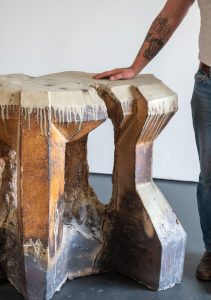
Holloman, a wood-fired stoneware piece, was exhibited during the 2024 Ceramic Furniture exhibition at Guild Gallery in New York City.
It’s easy to see why he requires this kind of space. Bags of sculpture clay from the Archie Bray Foundation in Helena, Montana, are stacked along low shelves. This clay forms the core of Zablocki’s large-scale works. Specially formulated for strength and durability, the clay can handle the scale and stress of woodfiring without collapsing or cracking. Zablocki hollows and lattices all his pieces internally to keep them light and structurally sound.
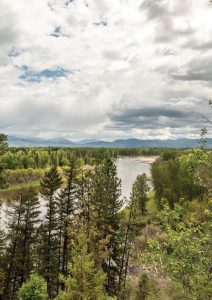
Zablocki fires his pieces in an anagama kiln tucked into a mountain slope near Missoula, Montana.
To this foundation, the artist adds clay that he’s dug by hand from the surrounding Montana landscape. This local clay colors the surface of his pieces, bringing depth and unpredictability. When fired in a wood kiln, its minerals flash and melt into earthy hues: rust reds, purples, oranges, blues. “If I just used my sculpture clay, it would be boring,” he says. “In order to get color, I harvest clay from Montana and paint it on there. And so I have all these local clays, and it makes sense that my work references the landscape it came from.”
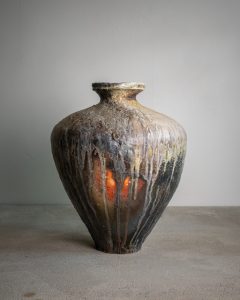
Retika, a large jar, appears to glow from the red-orange spontaneous flashing that occurred during the wood-firing process.
Zablocki has access to multiple kilns locally, including at the Clay Studio of Missoula. However, a defining aspect of his process takes place high on a mountain on the west side of the valley in the community-built Japanese-style anagama kiln, which is built into the hillside, using the earth as insulation. Imagine a wine bottle lying on a slope: pottery is stacked deep into its chamber, and the base is sealed with bricks, save for small ports where wood is fed for days. As the fire roars from the entrance and out through the narrow flue, flames pass around and between each vessel, transforming their surfaces in unpredictable ways. “You can’t get those surfaces any other way,” Zablocki says. “You put it in the fire, and it comes out marked by time.”
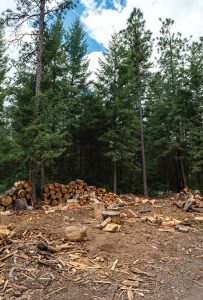
A woodpile is ready to feed the artist’s anagama kiln. The flame and ash from the wood directly impact the pottery.
Zablocki’s practice is more than technical; it’s spiritual. He calls woodfiring primal and notes that it can translate guttural emotion. He believes that one way to make modern ideas for ceramics is to relate them to the past. It’s clear that his kind of ceramics are as much about character as they are about craft, and that he is devoted to process, material, and place — and also to the unknown.
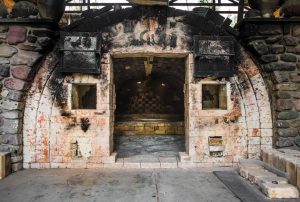
The entrance to the anagama kiln, a Japanese term meaning “cave kiln.”
Though Zablocki is anchored in Missoula, his story began in motion. He grew up on Michigan’s Upper Peninsula, which he describes as “not having many people, super slow pace, a lot of nature and water. A lot of mosquitoes, too.” He studied ceramics at Finlandia University in Hancock, Michigan, where he focused on pottery. During that time, he studied in Finland, where he learned about industrial ceramics and slip casting. He was also introduced to woodfiring, and he loved the process and the spontaneous, earthy surfaces it produced. He was hooked.
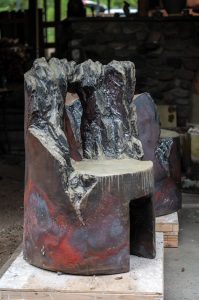
The Montana iron-bearing slip creates the spontaneous red flashing on Ralston, a wood-fired stoneware throne standing 40.5 inches tall.
After graduating college in 2008, he was teaching ceramics at a community pottery studio. Yearning to wood fire again, Casey connected with Ryan Dalman, a potter living off-grid in a maple forest outside Big Bay, Michigan, a few hours away. Dalman fired a massive Japanese-style noborigama kiln — which is a multi-chambered, wood-fired structure built on a slope — through the brutal northern winters. In exchange for chopping wood and shoveling snow off the roof, he was given free space in the kiln to fire his work.
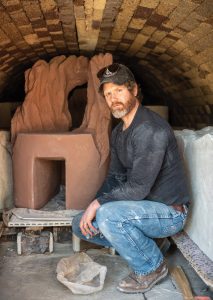
Artist Casey Zablocki arranges his artwork inside the anagama kiln. These ceramics were for his September 2024 show at Guild Gallery in New York City.
After Kayla McCormick, Zablocki’s girlfriend at the time and future wife, graduated from college, they jumped at the chance to move to Summit County, Colorado. Zablocki taught classes at a community arts center, made pottery, and worked as a furniture mover. He had a few art shows and was experimenting with a coffin kiln, a type of wood-fired kiln characterized by its elongated shape, but even with access to studio space and kilns, he was hitting a wall. “I was getting bored with the pottery I was making,” Zablocki says. “I was looking for something, and Kayla was like, ‘If you’re going to do this as a living, you need to go figure this out.’” He quit his job and began seeking out ceramicists he admired, offering to assist them in exchange for guidance and access to wood-fire kilns. This search took Zablocki across the country — to Arkansas, North Carolina, New Jersey, and beyond. It was a restless, exploratory time, but one that pushed him to grow and shape his voice as an artist.
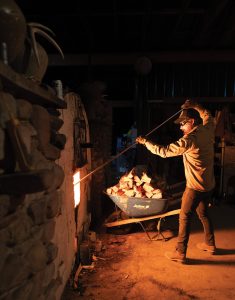
The artist turns the deep coal beds to keep the anagama ablaze.
In early 2012, his exploration led him to Montana State University (MSU) in Bozeman, where he earned a post-baccalaureate and studied with ceramicist Josh DeWeese.
Then Zablocki returned to Denver, where he worked in restaurants to support himself. He made ceramics at a studio in Fort Collins and would drive over eight hours to Bozeman to fire his work.
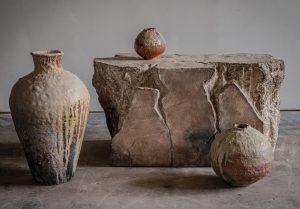
Carmine, a wood-fire stoneware bench Zablocki made in 2024, with a selection of jars.
Drawn to Montana, he applied and was accepted to a wood-fire residency at the Clay Studio of Missoula in 2013. The two-year wood-fire residency allowed him to focus on ceramics. During the second year of his residency, he began collaborating with Ty Best, creating ceramic furniture for his design studio, Caste. Best’s distinctive style, shaped by fashion and high-end design, influenced Zablocki’s sense of where ceramics might take him.
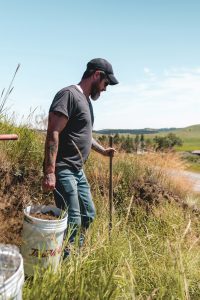
The artist carries a bucket of clay he dug up from a steep hillside in Montana’s Belt Mountains.
But after his residency was over, he found himself at a crossroads. He had started building wood-fired ovens for bread and was on the verge of quitting ceramics to start a bakery with a friend. Just as he was about to commit to a new venture, his former professor and mentor at MSU, ceramicist Josh DeWeese, urged him to go to Korea and work for renowned ceramic furniture pioneer Hun Chung Lee. Zablocki was hesitant at first, but the next day, Hun called to extend an invitation, and two weeks later, Zablocki was on a plane to Korea. That experience opened his eyes to new directions in function, design, and tradition. And it gave him a clearer understanding of the aesthetic and discipline he wanted.
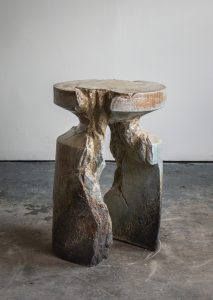
Estara, a side table made of Montana stoneware and porcelain, looks like Zablocki dug it from the earth.
ablocki’s career has moved quickly in a few short years. For a long time, he wasn’t interested in making money. He just wanted to be nomadic and to create. That shifted when his mentor Steve Sarroff laid it out clearly: If you’re working a job 30 hours a week, you’re not making art; and to make art, you have to sell it.
He took the advice seriously, setting his sights on ceramic furniture and interior design pieces, which was a niche idea at the time. His work gained traction, and when the Roman and Williams Guild approached him about showing work, everything accelerated.
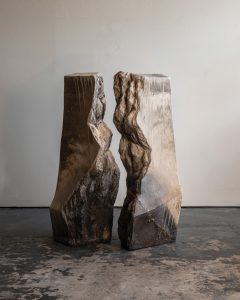
A Los Angeles collector commissioned this wood-fired piece.
The Guild Gallery showcases the work of emerging and established artists from around the world, with an emphasis on materiality and craft. Founded in 2021 by Stephen Alesch and Robin Standefer, principals of the architecture and design studio Roman and Williams, the gallery placed Zablocki’s work in hotels, high-end homes, and other eclectic places that the firm designed.
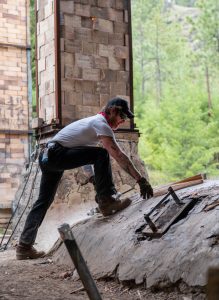
Zablocki’s anagama kiln is a sculptural feat in its own right.
For the artist, commercial success is not contradictory to his values — it’s a platform. He teaches his assistants to think about their own branding and professional sustainability. “I never really bought into the poor artist ideal,” he says. He sees financial success as a way to support emerging artists who can’t yet afford space or materials. His Missoula studio, already a production hub, is evolving into a gallery space for showcasing younger talents. “That’s part of the vision.”
Ceramics were a much more solitary pursuit for Zablocki, but now they are more expansive and collaborative. His assistants help him on a daily basis; Kayla handles his operations, marketing, and branding; and there are sales teams through the galleries. And at age 42, spending more time in one place has helped nurture his relationship with his work through the land. Sometimes, he imagines that his finished pieces are artifacts pulled from the earth — weathered forms, products of fire and erosion, buried somewhere between the mountains and the ocean for 10,000 years.
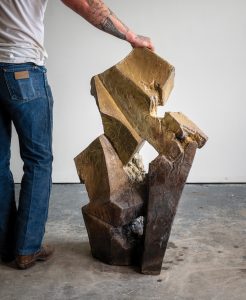
Ambergris, one of Zablocki’s recently completed sculptures, is composed of remnants of other sculptures and furniture.
“My work references time and decay, and these things happen to all of us,” Zablocki says. “And in order to really understand, you have to go through things in life. Life’s not easy. I didn’t want to share my art in the beginning because I didn’t want anyone to give me feedback about it. I didn’t care what they thought. And I think, you know, getting past all those things has helped me grow. I think maybe I’ve changed, and my work has changed with me.”
For Zablocki, just like with the landscape, change isn’t meant to end. “I think change takes time, and I think it’s never really finished,” he says. “This is the best work I could possibly make right now. But it won’t be my best ever.”





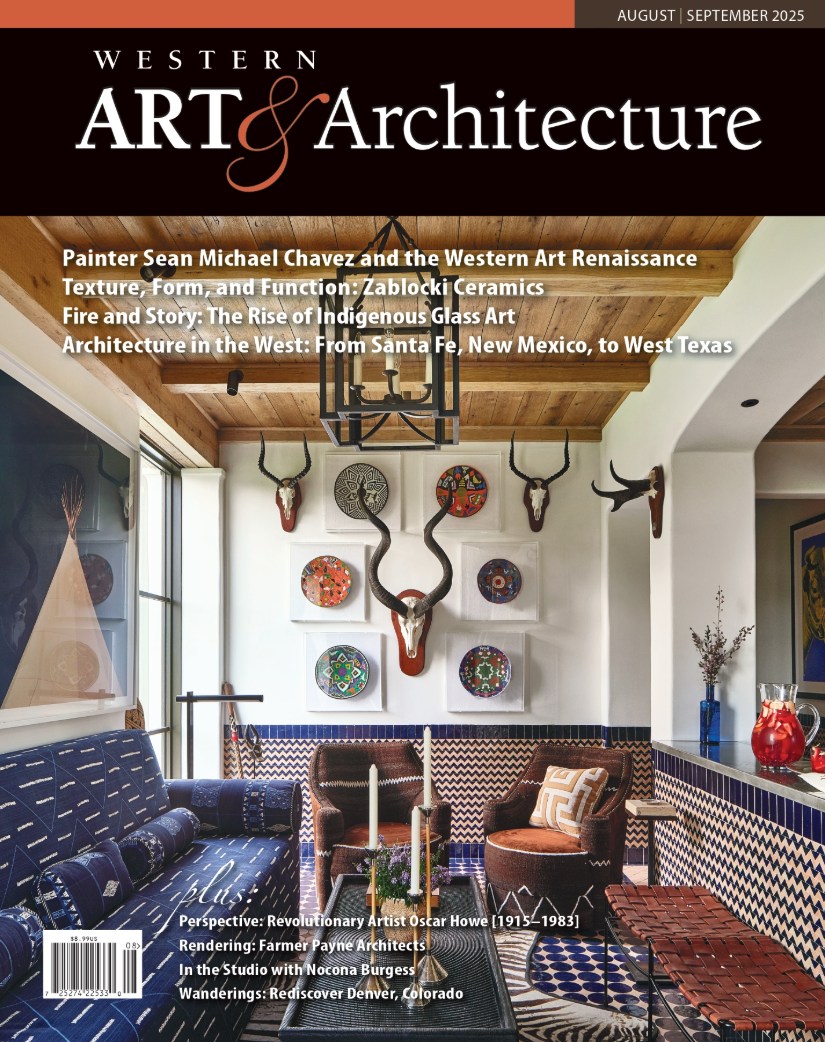
No Comments